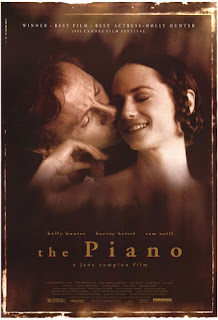December 20th: THE NEW WORLD (Terrence Malick, 2005)
NOTE: This film will be projected in the high-definition Blu-ray format.
The conflict between early European settlers of Virginia and the local Native American tribe is contrasted with the romance between Captain John Smith and Pocahontas.
Writer-director Terrence Malick made two acclaimed features in the 1970s before taking a nearly 20-year hiatus, during which he wrote and planned various projects. One of them was The New World. After his comeback in 1998 with The Thin Red Line, Malick developed a biopic of Che Guevara, but eventually dropped out when securing funding became problematic, and he revisited his earlier script.
Malick was very concerned with authenticity in every aspect of the film. Native American extras and featured actors were asked to learn a dead language to more accurately reflect history. John Smith's published journeys were studied, as well as other eyewitness accounts of the Jamestown settlement, texts about the natives and history of art from the time period. It was shot on location in Virginia and in various places in England.
Working for the first time with cinematographer Emmanuel Lubezki, the pair agreed on a loose set of rules, including a reliance on natural light, favoring of handheld shots, and preference for "deep focus" photography. They also managed to shoot some scenes on the rarely-used higher-resolution 65mm film. The camera crew was told to prepare for 360 degrees of shooting, with actors encouraged to move around as they saw fit.
The cast is headed by Colin Farrell, joined by Christian Bale, Christopher Plummer (The Insider, Beginners), John Savage, as well as actors with Native American heritage: Wes Studi (Last of the Mohicans, Heat), August Schellenberg, and the newly-discovered Q'orianka Kilcher as Pocahontas.
After 3.5 months of shooting, Malick began a long post-production process, using up to four editors. Like previous films, he slowly uncovered a shape not necessarily planned during the writing or even the shooting process. Taking his style to a new extreme, he abandoned traditional scene construction and normal coverage, finding a new poetry and balance between his characters and their place in the natural world.
The film was originally released in a 150-minute cut but pulled after 2 weeks for further tinkering. It re-appeared nearly a month later in a 135-minute, more clarified version using alternate footage. It received mixed reviews, did poorly at the box office, and had little awards traction. Several years later, an 172-minute extended cut appeared, with even more additions and substitutions. It is now regarded as one of the finest films of its decade.
The conflict between early European settlers of Virginia and the local Native American tribe is contrasted with the romance between Captain John Smith and Pocahontas.
Writer-director Terrence Malick made two acclaimed features in the 1970s before taking a nearly 20-year hiatus, during which he wrote and planned various projects. One of them was The New World. After his comeback in 1998 with The Thin Red Line, Malick developed a biopic of Che Guevara, but eventually dropped out when securing funding became problematic, and he revisited his earlier script.
Malick was very concerned with authenticity in every aspect of the film. Native American extras and featured actors were asked to learn a dead language to more accurately reflect history. John Smith's published journeys were studied, as well as other eyewitness accounts of the Jamestown settlement, texts about the natives and history of art from the time period. It was shot on location in Virginia and in various places in England.
Working for the first time with cinematographer Emmanuel Lubezki, the pair agreed on a loose set of rules, including a reliance on natural light, favoring of handheld shots, and preference for "deep focus" photography. They also managed to shoot some scenes on the rarely-used higher-resolution 65mm film. The camera crew was told to prepare for 360 degrees of shooting, with actors encouraged to move around as they saw fit.
The cast is headed by Colin Farrell, joined by Christian Bale, Christopher Plummer (The Insider, Beginners), John Savage, as well as actors with Native American heritage: Wes Studi (Last of the Mohicans, Heat), August Schellenberg, and the newly-discovered Q'orianka Kilcher as Pocahontas.
After 3.5 months of shooting, Malick began a long post-production process, using up to four editors. Like previous films, he slowly uncovered a shape not necessarily planned during the writing or even the shooting process. Taking his style to a new extreme, he abandoned traditional scene construction and normal coverage, finding a new poetry and balance between his characters and their place in the natural world.
The film was originally released in a 150-minute cut but pulled after 2 weeks for further tinkering. It re-appeared nearly a month later in a 135-minute, more clarified version using alternate footage. It received mixed reviews, did poorly at the box office, and had little awards traction. Several years later, an 172-minute extended cut appeared, with even more additions and substitutions. It is now regarded as one of the finest films of its decade.










Comments
Post a Comment